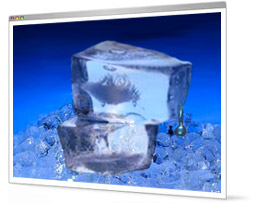My UPD8
You need to login before you download the free activities. You can register here.
- The Centre for Science Education
- The Association for Science Education
- Partners
- Part of ASE online
Watching the ice

Type: Activity
Learning Strategy: Communication
Topic: Atmospheric pollution
European Space Scientists have just decided to put an eye in the sky to see how fast the ice caps are really melting. It is going to be expensive and risky. A previous attempt cost �95m and ended in disaster. But a successful mission should at last yield reliable data on this key indicator of global warming. In this activity students get to speak up in favour of using government funds for big science projects. The activity also provides a good introduction to revision sessions on gravity and space, environmental chemistry or heating and cooling.
Published: 9th March 2006
Reviews & Comments: 0
Learning objectives
Students will:
-know about a use of artificial satellites
-appreciate that scientists work together to collect information and make predictions
-recognise where data is not sufficiently strong to support conclusions
-use the particle model to associate heating with changes of state and expansion
Try the activity
- Activity sheet
Downloaded: 3341 times - Teachers notes
Downloaded: 1785 times
You will need Acrobat Reader installed to open the activity sheets.
Curriculum link
Gravity and space QCA 9J:What keeps the planets and satellites in orbit?
Environmental Chemistry QCA 9G:
Is global warming happening?
Heating and Cooling QCA 8I:
How do materials change when they are heated and cooled?
Running the activity
Page 1 sets the context. The lack of reliable data makes it difficult to estimate the seriousness of global warming. Average temperatures are rising though, and the concentrations of greenhouse gases like carbon dioxide are increasing. Most scientists think there's a connection. The worry is that global warming might accelerate. Only the ice sheets over Greenland and the Antarctic will contribute directly to a rise in sea level, because there is no land under the Arctic ice.
Page 2 introduces the Cryosat mission and the failed launch that wrecked Cryosat 1. The key point is that big science projects like this cost a lot of money and require international collaboration. How satellites stay in orbit, and the use of different orbits for different jobs, could also be discussed if appropriate.
Page 3 gets students to compare different media reports on the plans for Cryosat 2. Students are expected to write a justification for the project drawing on the ideas presented.
Web links
News links
- BBC
- A summary of the latest findings from each ice cap.
- ESA
- Stream or download a video talk from the European Space Agency Site covering:
Track 1: Are the polar ice caps melting?
Track 2: The influence of the ice
Track 3: A three-year mapping mission - ESA
- Download a 22MB animation that explains what Cryosat will do.
- ESA
- Low resolution videos explaining Cryosat's role. These are not good enough to use with an interactive whiteboard but are an engaging source of information for individual use.
- CBBC
- A useful summary on global warming.
- NASA
- Images of polar and geostationary orbits and examples of their use.
Reviews & Comments
Write your online review to share your feedback and classroom tips with other teachers. How well does it work, how engaging is it, how did you use it, and how could it be improved?

200 lessons and assessments from as little as £4.95
Related Activities
Ideas about Science / Communicating science
- Emergency
- Addicted to energy
- Time raiders - death of a mummy
- Instant ice-cream
- Climate Futures Introductory Task
- Green Biker
- Food for Thought
- Smart Energy
- Garbage Gurus
- Backstage science
- Three Parents
- Obesity and cancer
- Speedy sperm
- Ellen's moments
- Green cars
- Mite Attack
- The Day After Tomorrow
- Journey to the Centre of the Earth
- Stardust
- Pompeii: the movie
- Parched Summer
- Can Science catch a bomber?
- Climate Change - what will YOU do?
- Hot Rocks
- In the limelight
- Think big
QCA / 9J Gravity & space
Chemistry / Atmospheric pollution
- Addicted to energy
- Global Warming Swindle
- Glacial meltdown
- Climate control
- Our atmosphere: the hottest investment on the Planet!
- Is Glastonbury Sustainable?
- Carbon Control
- The Day After Tomorrow: The Prequel
- The Day After Tomorrow
- Climate Change - what will YOU do?
- Secrets from the ice
- Global warming-do 'the facts' stand up?
- Endangered Polar bears
Earth Science / Atmosphere & climate change
- Addicted to energy
- Climate Futures Introductory Task
- Green Biker
- Food for Thought
- Smart Energy
- Global Warming Swindle
- Glacial meltdown
- Climate control
- Our atmosphere: the hottest investment on the Planet!
- Secrets from the ice
- Climate Change - what will YOU do?
- The Day After Tomorrow: The Prequel
- The Day After Tomorrow
- Global warming-do 'the facts' stand up?
Learning Strategy / Communication
- Deodorants & breast cancer
- SpaceShipOne
- Obesity and cancer
- The Day After Tomorrow: The Prequel
- Mite Attack
- Love on the brain
- Football's footprint
- Green cars
- Journey to the Centre of the Earth
- Urine combats acid rain
- Chernobyl 20 years on
- Camel Milk
- Our atmosphere: the hottest investment on the Planet!
- Isotope kills ex-spy
- Climate Change - what will YOU do?
- Water for All
- The future in your genes
- The future in your genes
- Friendly Floaters
- Sea tubes to solve climate crisis?
- Sea tubes to solve climate crisis?
- Garbage Gurus
- Smart Energy
- Food for Thought
- Green Biker
- Climate Futures Introductory Task
- Bears in trouble
- Emergency